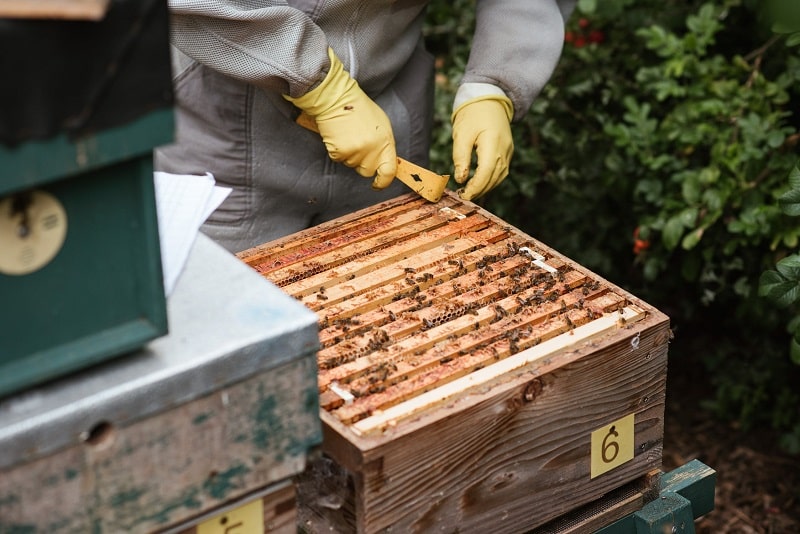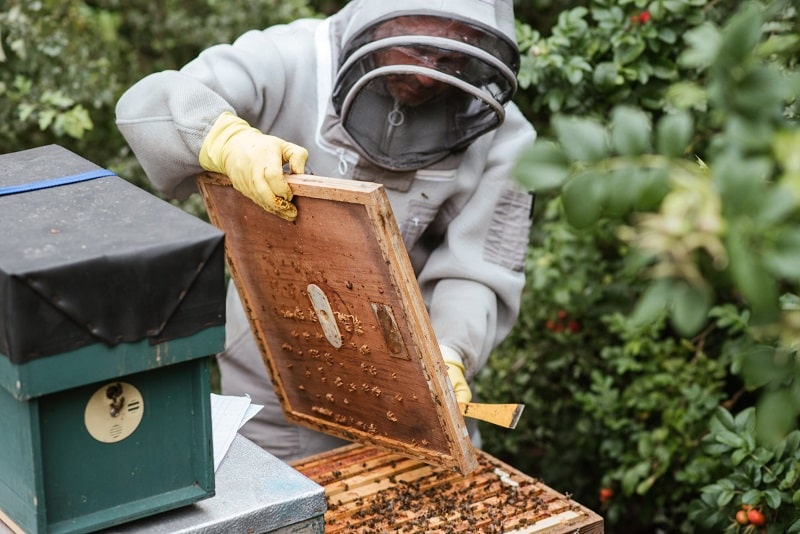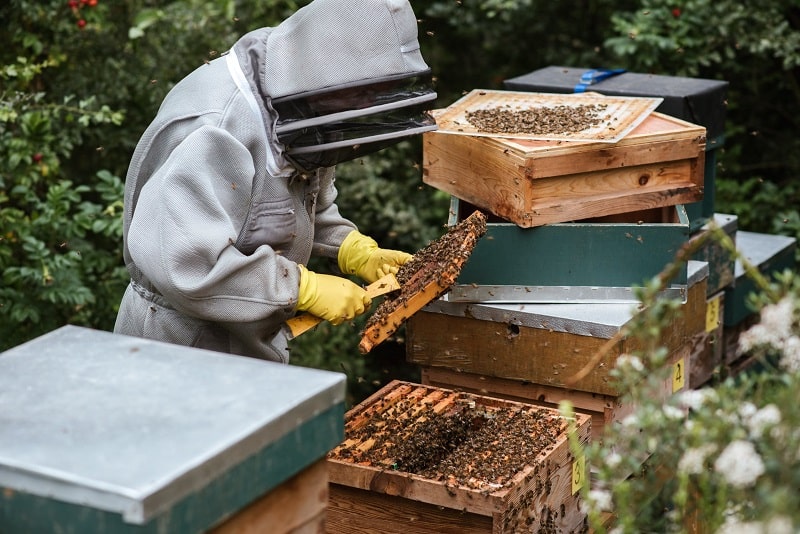Beekeeping is a physically demanding task, especially because beehives must be cleaned at regular intervals. Beehives will collect propolis, old wax, dirt, hive detritus, and poor honey. Pests, parasites, and diseases thrive in filthy hives. Cleaning their hives leaves the gloves filthy and sticky from the debris of the beehive and the stings put on them by bees while you are doing your work. So, how to clean beekeeping gloves?
Beekeepers often employ three types of gloves: leather, cloth, and synthetics (rubber, nitrate, neoprene, etc.). Each substance cleans up in a unique. You may be confident that you will be able to effectively clean your beekeeping gloves regardless of the type you use. We will explain how.

How to clean various types of beekeeping gloves
First, let’s look at the most commonly used kind of beekeeping gloves:
- Leather gloves (cow leather, pigskin, goatskin, etc…).
- Rubber, latex, neoprene, and nitrile gloves.
- Garden gloves, work gloves, etc…
We will not have to do much cleaning if we wear rubber, latex, or nitrile gloves. Even after hive inspections, you can easily change them to avoid cross-contamination and keep both you and the bees cleaner. The washing machine is also safe for neoprene gloves.
The leather and fabric gloves can get extremely messed up over time. They cannot be replaced readily or regularly, and, as a result, they must be cleaned on a regular basis.
You can take your beekeeping gloves off and clean them. It is preferable if you wash them as soon as possible. You will achieve the finest outcomes this way. Otherwise, the wax or honey will harden as it dries, and the substance will readily penetrate the fabric, setting deep inside the fibers of your gloves.
How to clean synthetic beekeeping gloves
Synthetic gloves are the most easily cleaned. They can be created from a variety of materials, including: Nitrile, neoprene and latex. They all clean up with soap and warm water. Some beekeepers keep a pail of warm water nearby so that they can rapidly rinse off many times while working in their hives. This type of thing makes the final cleanup a little easier.
Synthetic gloves can be washed in the same machine as the rest of your clothing if that is more convenient. On the other hand, they should never dry in the dryer. They will be harmed by the intense heat.
- Disposing of synthetic gloves
You should also be aware that some people wear synthetic gloves since they are inexpensive and easy to dispose of after a single use. Others are concerned about the trash generated, so they keep cleaning their synthetic gloves for as long as they can.
Finally, the decision is yours. By discarding synthetic gloves after each usage, you can avoid needing to clean them. If you want to reduce waste, clean nitrite, neoprene, and latex using warm water and hand washing soap.

How to clean fabric beekeeping gloves
Fabric gloves are typically gardening or work gloves. They provide slightly more protection against stings than thin synthetics. However, they do not provide the same level of protection as genuine leather.
The ease with which propolis, wax, and filth enter fabric gloves is the most difficult issue in cleaning them. In our experience, you should avoid wiping your gloved hands with a rag or paper towel. Instead, grab a spatula or a dull knife. Here’s what you do:
- Scrape away as much loose honey and propolis as you can
- Use your tool to loosen and remove crusted wax
- Soak the gloves in hot water and a pre-wash solution to loosen stains
- Wash the gloves in hot water using detergent and a fabric-safe bleach.
Natural cleaning solutions
White vinegar and lemon juice are our favorites. Both are extremely effective at removing surface stains and stains. White vinegar is so effective. It is such an all-purpose cleaner that it is often recommended. Then dry your fabric gloves in the sun after treating them with vinegar or lemon juice. The sun’s energy will combine with the vinegar or lemon juice to sterilize your gloves, leaving them fresh and clean.
Read more:
How to clean leather beekeeping gloves
Leather gloves are arguably the most commonly used type of beekeeping gloves. There is also a solid reason for this, since they give excellent protection against stings. The main disadvantage is that they can get very stiff after washing and that you can easily crush bees because you won’t be able to have excellent sensitivity while wearing them.
Here are the steps you can use to clean leather gloves:
- Start by scraping them with a spatula or dull knife. Remove as much loose material as you can.
- Wash the gloves using a mixture of warm water and hand soap or a mild detergent.
- Soak the gloves overnight in cold chlorine water to remove any remaining dirt and loosen stains.
- Rinse the gloves thoroughly and then dry them in the sun.
You do not have to worry about causing damage to your leather items by washing them on a frequent basis because leather is extremely durable. However, use caution when handling the chilly chlorinated water. By definition, chlorine is highly corrosive. If you are not careful, it can irritate your skin. Always fully clean your hands after handling it.
So, after using any alcohol on the leather, make sure to condition and oil it. The optimum time to oil the gloves is soon after cleaning while they are still somewhat damp. This allows the oil to penetrate deeper and more completely into the leather. Make certain that the chemicals used in the leather conditioner and its aroma will not harm or annoy the bees.

A few more points to consider
Several beekeepers claim that when they wear nitrile, their bees rarely strike them. Nobody appears to know why this is the case. Some assume that it has something to do with the fact that nitrile is synthetic. Perhaps the bees are antipathy to it.
Conclusion
While working on the job site, you can fill a bucket or a plastic basin with hot water. Then, while wearing the gloves, place your hands in the bucket and try to move them around as much as possible to scrape off the substances. The warm water will dissolve part of the wax and propolis. After that, let them dry in the open air.
When it comes to leather gloves, you should keep in mind that they always use adequate (and bee-friendly) conditioning oil.
Related Posts:
